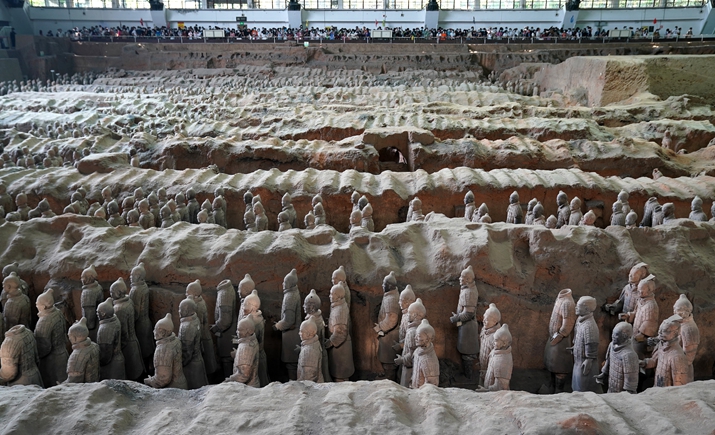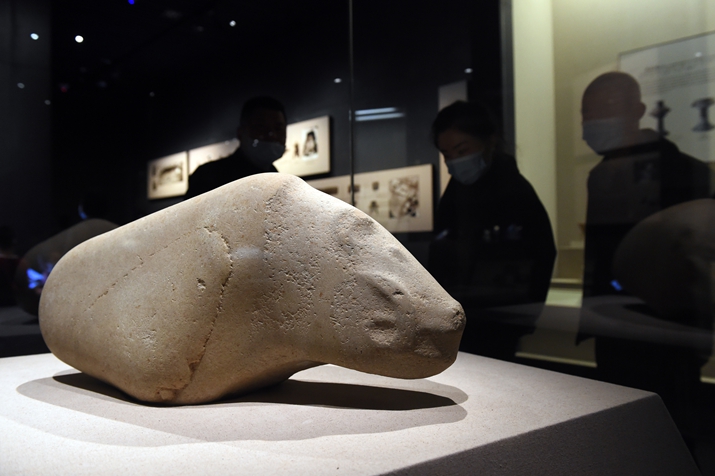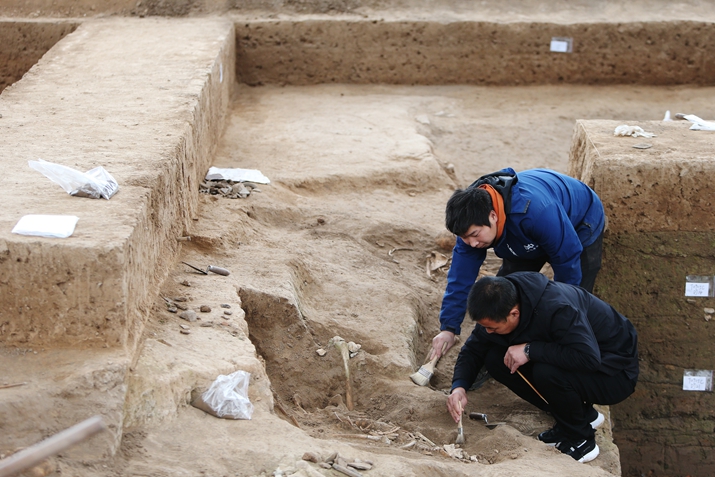| China |
| China celebrates 100 years of modern archaeology | |
|
|
 Tourists visit Emperor Qinshihuang's Mausoleum Site Museum in Shaanxi Province on October 2 (XINHUA)
It was a day in October 1921 that a tall foreign man appeared in the small village of Yangshao, in Henan Province of central China. This Swedish geologist, Johan Gunnar Andersson, had originally been invited to China as a mining adviser in the 1910s. However, a few pieces of pottery brought back from this village by his Chinese assistant made him suspect the existence of something more precious than mines. With the permission of the Chinese Government, Andersson organized a team of eight, including five Chinese and three foreigners, and started their excavation in the village. They brought tents with them, and borrowed shovels and baskets from villagers. This was all the equipment the team used for the project. The 36-day excavation at 17 locations around the village unearthed painted pottery pieces and stone artifacts that were identified as materials from a Neolithic culture dated to 5000-3000 B.C. "The findings are of great significance as the prevailing opinion internationally in those days was that China had no prehistoric culture and that Chinese civilization was imported from the West," said Wang Wei, Director of the Institute of Archaeology at the Chinese Academy of Social Sciences. "It was the first time people in China came to understand that we are able to study history through field excavation." With many breakthroughs being made during the excavation, the humble village of Yangshao became the birthplace of modern Chinese archaeology, and the year 1921 was marked as the beginning of China's modern archaeology.  Visitors view pig-shaped jadeware excavated from the Liangjiatan relics site, at Anhui Museum in Hefei, Anhui Province, on October 30 (XINHUA)
Unearthing history "Yangshao Village has witnessed the birth and growth of Chinese archaeology over the past 100 years," Wei Xingtao, an archaeological researcher from Henan Provincial Institute of Cultural Heritage and Archaeology, said at an event marking the 100th anniversary of the birth of modern Chinese archaeology on October 17. "It is the cradle of many Chinese archaeologists and many big names in archaeological circles have been involved in excavations in the village." Yangshao Culture, named after the village, is China's first named prehistoric culture. The culture emerged in the middle reaches of the Yellow River and in the decades since its discovery, its relics have been found across 10 provinces and regions all over China. Encouraged by the excavation in Yangshao, Chinese archaeologists began embarking on tours of exploration, seeking to unearth concrete evidence of China's long history. "China has long boasted a civilization of over 5,000 years," Wang said. "These scholars wanted to prove that with tangible evidence." A series of milestone findings were made during the 1920s, including Yinxu, the ruins of the last capital of the Shang Dynasty (1600-1046 B.C.) and the Zhoukoudian site in Beijing, where the famous Peking Man skull fossil was unearthed and the remains were dated to between 200,000 and 700,000 years ago. In the following years, however, the efforts of archaeologists were hampered as China struggled through decades of war. After the founding of the People's Republic of China in 1949, archaeologists were finally able to resume the former pace of excavation in 1950. One year later, the second exploration of Yangshao Culture was launched, and nine tombs were excavated in the village. This extensive field work demanded an increased workforce of qualified archaeologists. In 1952, the School of Archaeology was established at Peking University. In 1956, Northwest University, based in Xi'an, capital city of Shaanxi Province, followed up by establishing a second Chinese school of archaeology. In the ensuing decades, a number of further excavations took place in other parts of China. Some surprising findings, including the Terracotta Warriors from the Qin Dynasty (221-207 B.C.), and the Mawangdui Tombs of the Han Dynasty (202 B.C.-A.D. 220) in Hunan Province, were all discovered in the 1970s. "As many artifacts were being discovered incidentally by farmers working in the fields, it was necessary to train rural people on how to protect them," Wang said. "A series of training classes targeting this group have been established in villages, mostly in Shaanxi and Henan provinces, where many significant findings were made." Archaeological study and research were then fast tracked by China's adoption of its reform and opening-up policy in 1979, and archaeologists' work began to expand to other areas, focusing more on preservation. "The findings made in the early decades were scattered around different parts of China and it has become an urgent task to gather all related data, and catalog the findings," Wang said. The Project for Tracing the Origins of Chinese Civilization began in 2001. Supported by the state, researchers have spent years excavating ruins at sites in four provinces, including Liangzhu in Zhejiang Province, where an inner city with an area of nearly 3 million square meters and a larger outer city dating back around 5,000 years were found. Based on the findings of this project, researchers concluded in 2016 that Chinese civilization can indeed be traced back more than 5,000 years. This conclusion was acknowledged at an international level in 2019, when the Liangzhu archaeological ruins were listed as a World Heritage Site by UNESCO with the description, "It represents the great achievements of the prehistoric rice-cultivating civilization of China over 5,000 years ago, and is an outstanding example of early urban civilization." At the Third China Archaeological Congress on October 18, the top 100 archaeological discoveries over the past 100 years were unveiled. They were selected from some 300 candidates. On the list, 33 discoveries are from the Neolithic Period, which in China is roughly defined as between 10,000 and 2,000 years ago. "These findings demonstrate how the academic achievements of Chinese archaeology have answered questions such as the origins of human beings, agriculture and Chinese civilization, as well as how a united country with multiple ethnic groups formed and developed in China," Wang said.  Archaeologists work at the site of the fourth archaeological excavation at Yangshao Village in Henan Province on October 15 (XINHUA)
Media popularization In August 2020, the fourth excavation of Yangshao Culture kicked off in Yangshao. Experts said uncovering the entire area of Yangshao Culture will probably take another 1,000 years. Another excavation project that came to an end in March was the Sanxingdui site, hailed as one of the most important ancient sites found in the 20th century. Discovered in the 1930s, any serious exploration on this site only started in the 1980s. The golden masks, jade and ivory artifacts, and bronzeware unearthed from pits in Sanxingdui are uniquely shaped and look totally different from the relics discovered in other sites of China. The excavation received intense media coverage, including a live broadcast of the whole excavation process. Gao Menghe, a professor of archaeology at Shanghai-based Fudan University, took part in the early excavation of Sanxingdui in 1987. "The conditions back then were very limited," Gao said at a lecture he delivered on campus this May. "We just pitched simple tents right beside the pits and our tools were mainly trowels." Embarking on his archaeology studies in the 1980s, Gao defines himself as part of the third-or-fourth generation of China's modern archaeologists. "What we studied in the 1980s was much simpler than what is taught today, as students now need to learn about the use of advanced technologies, which are extensively used in modern excavations." The new technologies, as Gao explained, include ground-penetrating radar, CT scanners, portable X-ray fluorescence spectroscopy, and light detection and ranging technology, which works by bouncing hundreds of thousands of pulses of light to survey an area. Sanxingdui has become an online sensation with multi-day live broadcasts of excavations this March. The hi-tech equipment used in the project, as well as its mysterious findings, made archaeological research a cool subject, especially among young people. Since the early 2000s, a series of documentaries have been produced to introduce archaeological findings to a wider audience, including National Treasures, Each Treasure Tells a Story and Masters in the Forbidden City, featuring craftsmen restoring damaged treasures in the Palace Museum in Beijing. "Archaeology has gained more fans through these efforts and is becoming known to more people," Gao said. Behind the relics Zhong Fangrong, whose college entrance score ranked fourth in Hunan Province in 2020, chose archaeology as her major. Her choice ignited heated online discussions as normally students with high scores choose traditionally popular majors such as law or finance. "I just want to follow my heart," Zhong said. "I am pretty sure archaeology is my real love." Her idol is Fan Jinshi, who was director of Dunhuang Research Academy between 1998 and 2014. "I was deeply touched by her efforts in preserving Dunhuang and want to follow in her footsteps." Her choice was applauded by many archaeological scholars. She received gifts from a number of museums as well as a gift from Fan herself, who encouraged Zhong to follow her passion for archaeological research. The national response to Zhong's decision hints at the not-so-optimistic outlook for archaeology graduates. Ma Yu, a master in the restoration of Terracotta Warriors, said of the almost 20 young students who began studying restoration under his supervision, only seven now remain, with the others leaving due to the low salary. "Archaeology is not only about digging. It has expanded to many areas, including preservation and restoration," Ma told China Central Television. "Today, there are only some 2,000 people working in this field nationwide, but there are more than 47 million relics in our country. There is a large gap to fill." Zhao Zhen, a fulltime photographer of the Terracotta Warriors, works in the museum at Emperor Qinshihuang's Mausoleum, where the warriors were unearthed. He has been working here for over 20 years and is optimistic about the outlook for young people in archaeology. He describes his job as the best one in the world and believes more youngsters will sooner or later come to see the charm of it. "Every warrior looks different and we are now making ID cards for each of them with their pictures printed on the cards," Zhao said. "Every time I see their eyes through my lens, I feel like I am talking with them." One day, he saw fingerprints on the upper lip of a warrior and was suddenly thrilled by the idea that the prints were most probably left by the craftsmen making the warrior over 2,200 years ago. "The mark was a living trace from our ancestors," he said. Yu Lei, director of the documentary National Treasures, had some new ideas on archaeology. "It is an interesting subject and it is closely connected to our lifestyle and even our personality," Yu said. "It helps us to find out where we come from and where we are headed." (Print Edition Title: Digging Into the Past) Copyedited by G.P. Wilson Comments to yuanyuan@bjreview.com |
|
||||||||||||||||||||||||||||
|